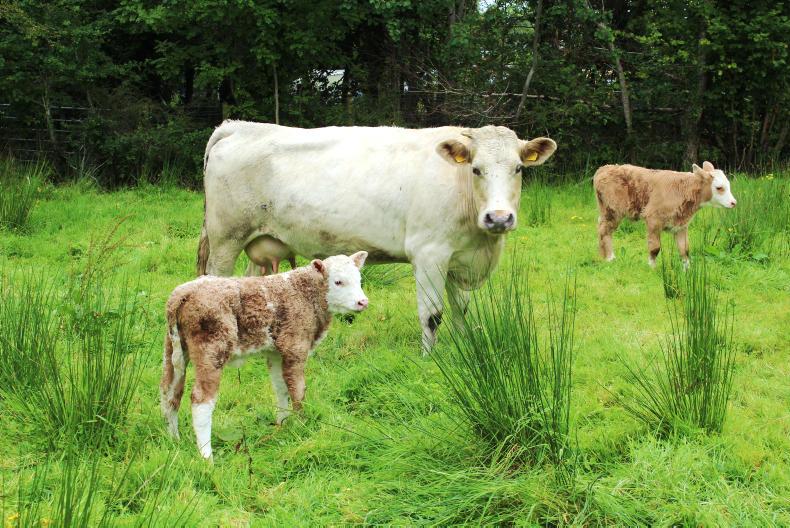On many Irish suckler farms, autumn calving gets under way in August, which means herd owners should be starting to plan ahead to make calving as problem-free as possible.
Calving in August and September means cows and calves can return to grass for a short period before the winter.
Not only does this reduce the workload and disease risks, it cuts down on feed costs. Outlined are five tips to start preparing cows for autumn calving.
1. Pre-calving minerals
Cows scanned in-calf for early August should be offered pre-calving minerals from early July. Minerals can be provided through a bolus or lick buckets specifically geared to pre-calving nutrition.
The alternative is to offer powdered minerals. However, as cows will need a daily allocation, this is less practical when animals are at grass.
That said, many farmers prefer this option, as they can see cows coming forward to feed and it gives an opportunity to inspect animals better.
2. Grazing cows close to the yard
Where dry autumn cows have been grazing on outfarms, these animals will have to be brought home to paddocks around the main yard later this month.
This will allow closer observation prior to calving. Ideally, you should have cows settled on paddocks close to the yard at least two weeks before predicted calving date.
3. Body condition
Autumn-calving cows will be fit, as they have been at grass, so don’t panic if animals are carrying a bit of extra condition.
Go through the cows and identify anything with a body condition score (BCS) above 3.5. Group these animals together in paddocks with low grass covers to control intake and gradually reduce condition.
For replacement heifers, animals should be calving in BCS 3, so again group these animals and manage grazing to have animals calving down in a fit state.
Where grass covers are strong, you will need to control intakes by strip grazing, splitting paddocks or increasing stocking rates.
4. Clean calving pens
Hopefully, the majority of cows will calve on their own and ideally outdoors. But, as a fall-back, make sure calving pens have been washed and disinfected before calving gets under way.
Also, carry out any repairs necessary to calving facilities during the next few weeks before they are needed.
5. Build up a grass wedge to graze after calving
Where cows calve down in August and September, start building a bank of grass for these animals later this month.
Ideally, regrowth on silage fields following second cut should be prioritised for autumn-calving cows.
Grazing high-quality aftermaths will drive milk production, reduce the need for concentrates and bring cows back into heat quickly. Just make sure cows are well covered for magnesium to prevent tetany.
Read more
THRIVE: adapting to the changing grazing conditions
Teagasc Virtual Beef Week farmer focus
On many Irish suckler farms, autumn calving gets under way in August, which means herd owners should be starting to plan ahead to make calving as problem-free as possible.
Calving in August and September means cows and calves can return to grass for a short period before the winter.
Not only does this reduce the workload and disease risks, it cuts down on feed costs. Outlined are five tips to start preparing cows for autumn calving.
1. Pre-calving minerals
Cows scanned in-calf for early August should be offered pre-calving minerals from early July. Minerals can be provided through a bolus or lick buckets specifically geared to pre-calving nutrition.
The alternative is to offer powdered minerals. However, as cows will need a daily allocation, this is less practical when animals are at grass.
That said, many farmers prefer this option, as they can see cows coming forward to feed and it gives an opportunity to inspect animals better.
2. Grazing cows close to the yard
Where dry autumn cows have been grazing on outfarms, these animals will have to be brought home to paddocks around the main yard later this month.
This will allow closer observation prior to calving. Ideally, you should have cows settled on paddocks close to the yard at least two weeks before predicted calving date.
3. Body condition
Autumn-calving cows will be fit, as they have been at grass, so don’t panic if animals are carrying a bit of extra condition.
Go through the cows and identify anything with a body condition score (BCS) above 3.5. Group these animals together in paddocks with low grass covers to control intake and gradually reduce condition.
For replacement heifers, animals should be calving in BCS 3, so again group these animals and manage grazing to have animals calving down in a fit state.
Where grass covers are strong, you will need to control intakes by strip grazing, splitting paddocks or increasing stocking rates.
4. Clean calving pens
Hopefully, the majority of cows will calve on their own and ideally outdoors. But, as a fall-back, make sure calving pens have been washed and disinfected before calving gets under way.
Also, carry out any repairs necessary to calving facilities during the next few weeks before they are needed.
5. Build up a grass wedge to graze after calving
Where cows calve down in August and September, start building a bank of grass for these animals later this month.
Ideally, regrowth on silage fields following second cut should be prioritised for autumn-calving cows.
Grazing high-quality aftermaths will drive milk production, reduce the need for concentrates and bring cows back into heat quickly. Just make sure cows are well covered for magnesium to prevent tetany.
Read more
THRIVE: adapting to the changing grazing conditions
Teagasc Virtual Beef Week farmer focus






 This is a subscriber-only article
This is a subscriber-only article









SHARING OPTIONS: